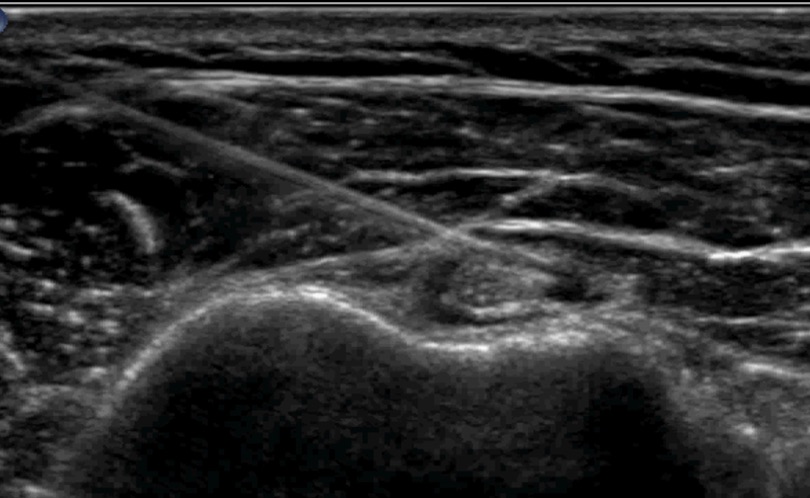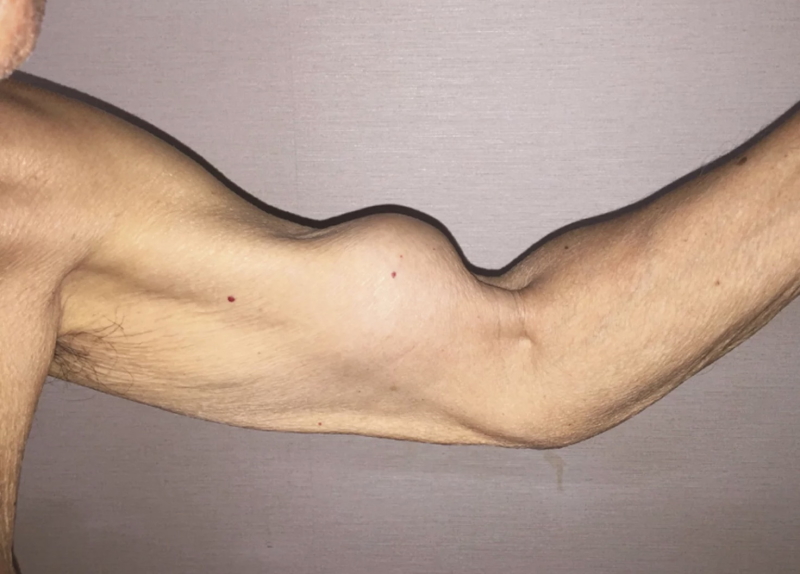Shoulder pain may be due to many causes, such as rotator cuff tendinosis, shoulder joint arthritis, and frozen shoulder. However, in some less common cases, shoulder pain is caused by the long head of the biceps tendon pain. So, can a long head of biceps tendonitis cause shoulder pain? And how do we separate the long head of biceps tendon injury from other common causes of shoulder pain?
What is the long head of biceps tendon?
The biceps muscle is a large muscle that sits at the front of the arm. Many people think that the biceps only acts on the elbow. However, the muscle and, more specifically, the tendon plays a role in helping the vital rotator cuff tendons in the shoulder.
Two tendons attach the biceps muscle to the shoulder: the ‘long’ head and the ‘short’ head. The long head passes into the shoulder joint through a groove in the arm bone and a hole in the rotator cuff. Finally, it attaches to the top part of the labrum.

Long head of biceps tendon injury
Most problems with the long head of the biceps tendon present with pain at the front of the shoulder. In addition, clicking or snapping is common. Also, problems in the long head of the biceps are commonly associated with rotator cuff tendon problems. So, treating the rotator cuff tendon pathology is essential as well.
Common problems of the tendon include:
- Long head of biceps tendonitis: Tendon swelling and inflammation can cause pain at the front of the shoulder. People with biceps tendonitis often complain of pain in the shoulder moving to the front of the arm.
- Biceps tendon subluxation/dislocation: In some people with rotator cuff tears, the biceps tendon may not be held in the groove in the upper arm. The tendon may snap out of the track. When the tendon is unstable, we call it subluxation; when it snaps out of the groove, we call it dislocation.
- Biceps tendon rupture: The tendon can be torn off entirely from its attachment with increasing damage. The tendon retracts back into the arm, causing a bulge in the biceps. It often looks like a ‘popeye’ muscle when flexing the biceps.
Treatment of long head of biceps tendonitis
In general, treatment of biceps tendonitis depends on the pathology.
Simple treatments, including ice, anti-inflammatory tablets, and physiotherapy, are effective for the long head of biceps tendonitis. Exercises that help biceps tendonitis include wall push-ups, single-arm rows, reverse flies, and prone planks. These exercises should be used in combination with general rotator cuff strengthening.
In more severe cases, injection therapy can help. Some doctors use cortisone directed to the groove containing the inflamed biceps tendon. Cortisone reduces tendon inflammation and pain but may lead to rupture. Other doctors use hyaluronic acid or PRP. It is essential to use ultrasound as evidence suggests improved accuracy and effectiveness compared to blind injections.
For biceps subluxation or dislocation, we suggest surgery. First, surgeons can cut the tendon, also called a tenotomy. Alternatively, they can cut the tendon and reattach it to the bone. Therefore, the muscle retains its function, but the shoulder problem resolves. Surgeons call this procedure tenodesis. Studies suggest there is very little difference in outcomes between these two procedures.
More on cortisone shot for biceps tendonitis

Generally, we target the biceps tendon sheath containing the long head of the biceps. The needle is placed carefully in the sheath using ultrasound guidance. It is important not to inject the tendon structure with cortisone due to the risk of rupture.
Evidence suggests that injecting the biceps tendon sheath with ultrasound guidance improves accuracy and effectiveness. Also, side effects are reduced. So, all in all, we should use ultrasound guidance for biceps tendon sheath injections.
Torn biceps tendon treatment

Most biceps tendon tears involve the long head close to the shoulder joint. Most cases of a torn long head of biceps tendon present with sudden pain, swelling, and bruising in the upper part of the biceps muscle. Sometimes, the biceps muscle bunches up and looks like a ‘popeye’ muscle.
We avoid operating on these common ruptures because pain and function are not significantly changed. However, we operate on biceps tendon ruptures near the elbow joint.
Other frequently asked questions about the long head of biceps tendon injury
Can bicep tendonitis cause elbow pain?
Yes. Tendonitis can affect the bicep at the attachment to the elbow. This injury is typical in gym-goers or weightlifters.
Other than cortisone, do we use other injectables for the long head of biceps tendonitis?
Yes. Cortisone can increase the risk of rupture. Alternatively, we use hyaluronic acid such as Durolane or Ostenil plus to reduce pain from biceps tendonitis. Importantly, hyaluronic acid needs to be directed by ultrasound guidance to get it accurately in the sheath.
Final word from Sportdoctorlondon about the long head of biceps tendonitis
The long head of biceps tendon problem is less common than other shoulder problems such as rotator cuff tendonitis, frozen shoulder, or AC joint arthritis. In general, we often see biceps tendon injuries with rotator cuff injuries. Moreover, treatment for this condition is similar to rotator cuff tendonitis.



Bad left shoulder blade had MRI received a letter I have degenerative changes in my AC joint I have swelling pain I will be having something done been going on for 12 years. Just been in contact with someone need to see specialists.
Hi Pauline, shoulder blad is commonly referred from the neck (disc pain). Also, AC joint degeneration is common in anyone over the age of 30-40 and may not cause pain. I agree you should see a doctor to sort it out.
my mri on the left shoulder shows an abnormal fluid collection in the bicpital grooveregion to suggest tendinopathy
collection of fluid in the biceps regions could be secondary to tendinopathy or fluid for the joint – need to make a clinical correlation